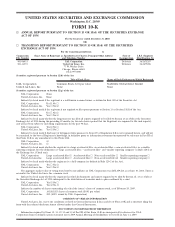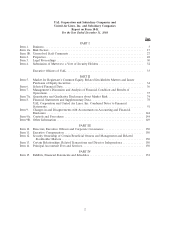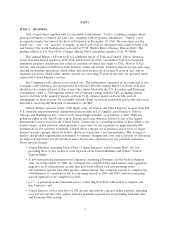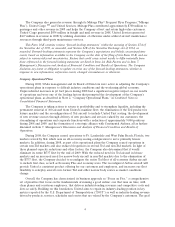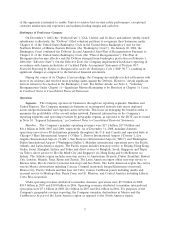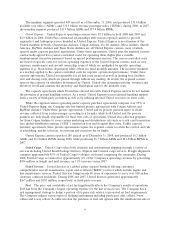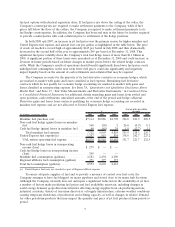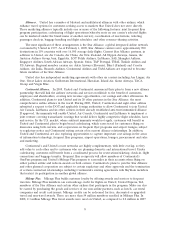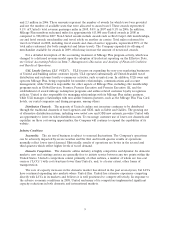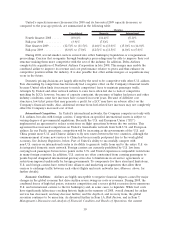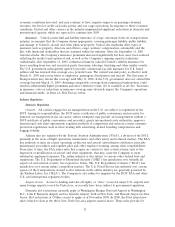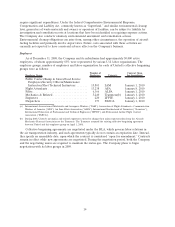United Airlines 2008 Annual Report Download - page 4
Download and view the complete annual report
Please find page 4 of the 2008 United Airlines annual report below. You can navigate through the pages in the report by either clicking on the pages listed below, or by using the keyword search tool below to find specific information within the annual report.The Company also generates revenue through its Mileage Plus»Frequent Flyer Program (“Mileage
Plus”), United Cargo
SM
and United Services. Mileage Plus contributed approximately $700 million to
passenger and other revenue in 2008 and helps the Company attract and retain high-value customers.
United Cargo generated $854 million in freight and mail revenue in 2008. United Services generated
$167 million in revenue in 2008 by utilizing downtime of otherwise under-utilized aircraft maintenance
resources through third-party maintenance services.
This Form 10-K contains various “forward-looking statements” within the meaning of Section 27A of
the Securities Act of 1933, as amended, and Section 21E of the Securities Exchange Act of 1934, as
amended. Forward-looking statements represent the Company’s expectations and beliefs concerning future
events, based on information available to the Company on the date of the filing of this Form 10-K, and are
subject to various risks and uncertainties. Factors that could cause actual results to differ materially from
those referenced in the forward-looking statements are listed in Item 1A, Risk Factors and in Item 7,
Management’s Discussion and Analysis of Financial Condition and Results of Operations. The Company
disclaims any intent or obligation to update or revise any of the forward-looking statements, whether in
response to new information, unforeseen events, changed circumstances or otherwise.
Company Operational Plans
During 2008, UAL’s management and its Board of Directors were active in adjusting the Company’s
operational plans in response to difficult industry conditions and the weakening global economy.
Unprecedented increases in jet fuel prices during 2008 had a significant negative impact on our results
of operations and were one of the leading factors that prompted the development of the Company’s
operational plans, as described in Note 2, “Company Operational Plans,” in Combined Notes to
Consolidated Financial Statements.
The Company is taking actions to return to profitability and to strengthen liquidity, including the
permanent removal of 100 aircraft from United’s mainline fleet; the elimination of the Ted product for
leisure markets and the reconfiguration of Ted aircraft to include United First seating; the development
of new revenue sources through delivery of new products and services valued by our customers; the
streamlining of operations and corporate functions with a reduction of approximately 9,000 positions
during 2008 and 2009; and the formation of a strategic alliance with Continental Airlines, all as further
discussed in Item 7, Management’s Discussion and Analysis of Financial Condition and Results of
Operations.
During 2008, the Company ceased operations to Ft. Lauderdale and West Palm Beach, Florida, two
markets served by Ted, which uses an all-economy seating configuration to serve primarily leisure
markets. In addition, during 2008, as part of its operational plans the Company ceased operations in
certain non-Ted markets and also reduced frequencies in several Ted and non-Ted markets. In light of
these planned capacity reductions and other factors, the Company also determined that it would
eliminate its entire B737 fleet by the end of 2009. With the reduced need for Ted aircraft in leisure
markets and an increased need for narrow body aircraft in non-Ted markets due to the elimination of
the B737 fleet, the Company decided to reconfigure the entire Ted fleet of all-economy Airbus aircraft
to include first class, as well as Economy Plus and economy seats. The reconfigured Airbus aircraft will
provide United a consistent product offering for our customers and employees, and increases our fleet
flexibility to redeploy aircraft onto former Ted and other narrow body routes as market conditions
change.
Overall, the Company has characterized its business approach as “Focus on Five,” a comprehensive
set of priorities that focus on the fundamentals of running a good airline: one that runs on time, with
clean planes and courteous employees, that delivers industry-leading revenues and competitive costs and
does so safely. Building on this foundation, United aims to regain its industry-leading position in key
metrics reported by the U.S. Department of Transportation (“DOT”) as well as industry-leading revenue
driven by products, services, schedules and routes that are valued by the Company’s customers. The goal
4

